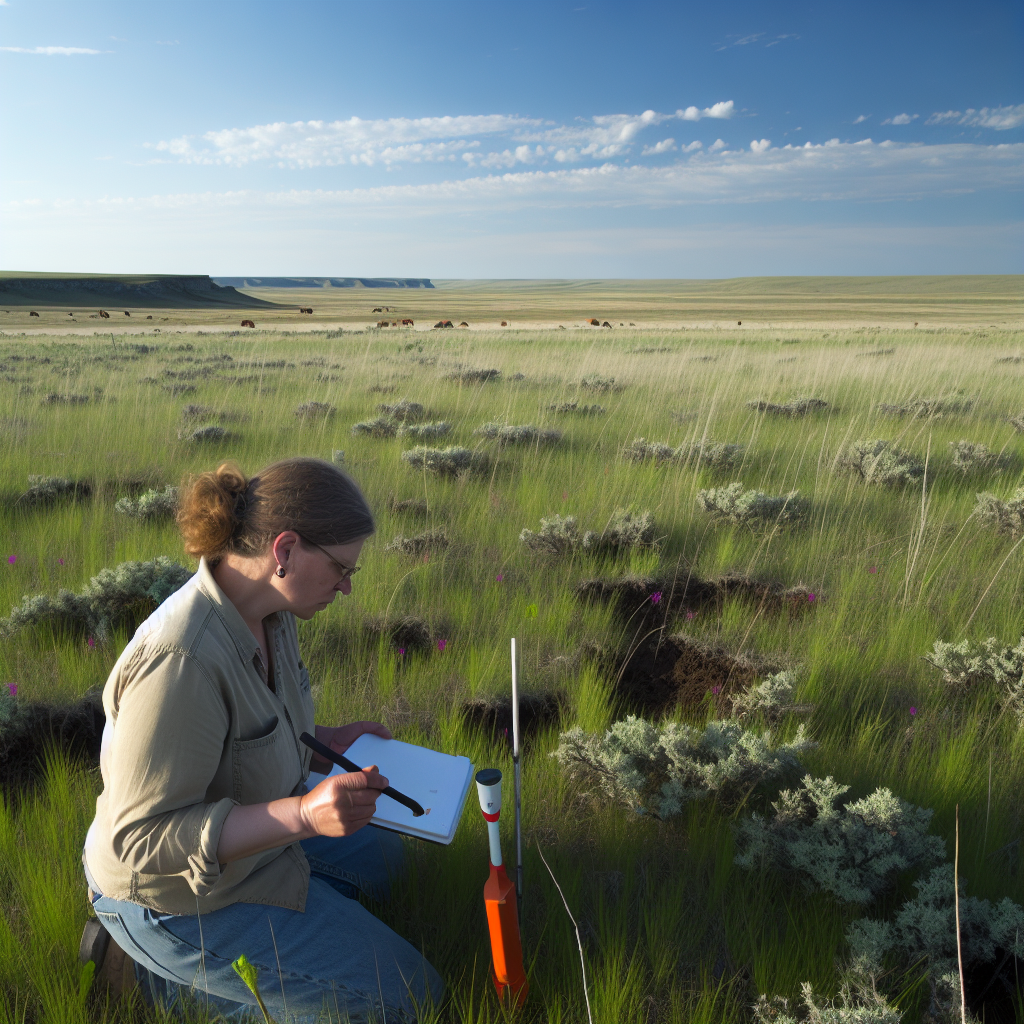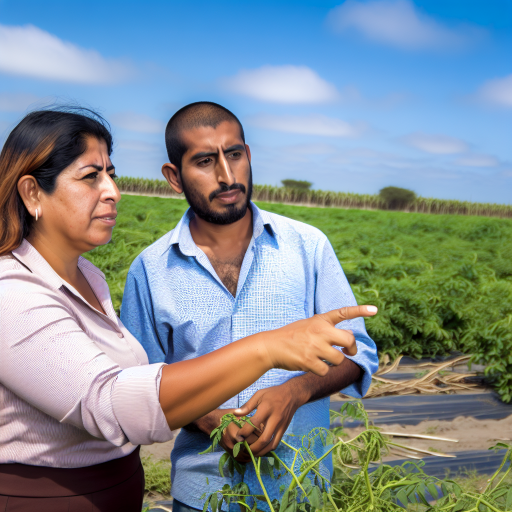Introduction
Rangeland health is essential for the sustainability of our ecosystems and agricultural industry.
Defining rangeland health
Rangeland health refers to the overall condition of the land and its ability to support diverse plant and animal species.
Importance of rangeland health
Maintaining healthy rangelands is crucial for watershed protection, soil conservation, biodiversity, and sustainable food production.
Understanding Indicators of Rangeland Health
Rangelands are vast landscapes that support a variety of plant and animal species.
This diversity makes them essential for ecosystem health and sustainability.
To ensure that rangelands remain healthy and productive, it is crucial to understand and monitor indicators of rangeland health.
These indicators provide valuable insights into the condition of rangeland ecosystems.
They help land managers make informed decisions about resource management practices.
Plant Communities
One of the key indicators of rangeland health is the diversity and abundance of plant species present in the ecosystem.
Healthy rangelands support a wide variety of plant communities, including grasses, forbs, and shrubs.
Monitoring changes in plant species composition can help identify potential issues.
These include invasive species encroachment or overgrazing by livestock.
Soil Health
The health of the soil in rangeland ecosystems is critical for supporting plant growth and overall ecosystem function.
Soil health indicators such as soil organic matter content, soil structure, and nutrient levels can provide important information about the condition of the soil.
Monitoring soil health can help land managers identify soil degradation issues.
They can then implement appropriate conservation practices.
Water Resources
Water availability and quality are essential for maintaining healthy rangeland ecosystems.
Monitoring indicators such as stream flow, water quality, and groundwater levels can help assess the health of water resources in rangelands.
Changes in water availability or quality can signal potential issues.
These include erosion, pollution, or water scarcity, which can impact plant and animal species that depend on these resources.
Transform Your Career Today
Unlock a personalized career strategy that drives real results. Get tailored advice and a roadmap designed just for you.
Start NowWildlife Habitats
Rangelands provide important habitats for a wide variety of wildlife species, including birds, mammals, and reptiles.
Monitoring indicators of wildlife presence and diversity can help assess the health of wildlife habitats in rangeland ecosystems.
Changes in wildlife populations or habitat quality can indicate potential disturbances.
These disturbances may include habitat loss, fragmentation, or degradation, which can have long-term impacts on ecosystem health.
Monitoring Rangeland Health
Rangeland health monitoring is crucial for assessing the condition of grasslands.
It ensures sustainable land use practices.
Methods and Techniques
- Remote Sensing: Utilizing satellite imagery to track changes in vegetation cover.
- Field Surveys: Conducting on-ground assessments to observe plant species diversity.
- Biological Indicators: Monitoring key species like indicator plants and birds.
Data Collection
- Sampling vegetation: Collecting data on plant species composition.
- Soil analysis: Testing soil fertility and moisture levels.
- Wildlife observation: Recording animal sightings to evaluate biodiversity.
Data Analysis
- Quantitative Analysis: Using statistical methods to analyze vegetation data.
- GIS Mapping: Creating maps to visualize spatial patterns of indicators.
- Trend Analysis: Assessing long-term data trends to predict changes.
Monitoring rangeland health involves a combination of fieldwork and data collection.
Additionally, analysis informs land management decisions.
By employing a comprehensive monitoring approach, land managers can track ecosystem changes.
This helps implement targeted conservation practices and ensures sustainability.
Learn More: Implementing Organic Farming Methods Successfully
Factors influencing rangeland health
Climate significantly impacts rangeland health.
Factors such as temperature, rainfall, and humidity affect productivity and resilience.
The management of grazing on rangelands is crucial for their health.
Proper practices include rotational grazing and rest periods.
Invasive species pose a serious threat to rangeland ecosystems.
These species can outcompete native vegetation and reduce biodiversity.
Additionally, human activities affect the health of rangelands.
Overgrazing, habitat destruction, and pollution are negative impacts.
Showcase Your Business Today
Reach thousands of readers actively exploring professional services. Publish your business profile and grow your audience now.
Publish NowUnderstanding these influential factors is vital for effective management.
Addressing climate change, grazing practices, and human impacts is essential.
This promotes the long-term health and sustainability of rangeland ecosystems.
Explore Further: Understanding Entomology Grants and Funding Opportunities
Impacts of Poor Rangeland Health
Poor rangeland health has detrimental effects on the environment.
It can significantly impact ecosystems and economic stability.
Decreased productivity is one of the primary consequences.
This results in reduced forage for livestock.
Ranchers and their livestock are affected by this decline.
Malnutrition may become common without adequate forage.
Soil erosion is another concerning impact of poor rangeland health.
As vegetation cover decreases, soil loses protection.
This exposure leads to erosion by wind and water.
Consequently, topsoil is lost, causing nutrient depletion.
This degradation exacerbates challenges within rangeland ecosystems.
Loss of biodiversity is a major consequence as well.
Healthy rangelands support diverse plant and animal species.
Each species plays a crucial role in maintaining ecosystem balance.
When rangeland health deteriorates, some species may vanish.
This disappearance disrupts the ecosystem’s balance.
Cascading effects may then occur for other species.
Water quality issues also arise due to poor rangeland health.
Erosion contributes to sedimentation in nearby water bodies.
This sedimentation negatively affects water quality and habitats.
Furthermore, degraded rangelands have impaired water infiltration.
This leads to increased runoff and potential contamination.
Improving rangeland health indicators is essential for sustainability.
Understanding these impacts helps society as a whole.
Efforts toward healthier ecosystems benefit future generations.
- Decreased Productivity
- Soil Erosion
- Loss of Biodiversity
- Water Quality Issues
Learn More: Supporting Local: The Rise of Community Supported Fisheries

Improving Rangeland Health
Improving rangeland health is essential for the sustainability of our ecosystems.
Sustainable Grazing Practices
Implementing controlled grazing practices can help prevent overgrazing.
This approach allows for the recovery of vegetation.
Rotational grazing promotes healthy plant growth.
It gives plants time to recover between grazing periods.
Proper stocking rates should be determined based on the carrying capacity of the land.
This helps to avoid degradation of the rangeland.
Rest and Rotation Strategies
Resting grazing areas periodically can help rejuvenate vegetation.
This also improves soil health.
Rotating livestock to different pastures can prevent overgrazing.
Showcase Your Business Today
Reach thousands of readers actively exploring professional services. Publish your business profile and grow your audience now.
Publish NowIt promotes plant diversity on rangelands.
Strategic rest periods allow forage plants to grow and reproduce.
This contributes to the overall health of the ecosystem.
Weed Control
Invasive plant species can outcompete native vegetation.
This degradation can harm rangeland ecosystems.
Implementing effective weed control measures is essential.
Mechanical methods such as mowing or hand-pulling weeds can be effective.
These methods work well for small-scale infestations.
Herbicide application may be necessary for larger infestations.
However, careful consideration should be given to potential environmental impacts.
Habitat Restoration
Restoring degraded habitats can promote biodiversity.
These efforts can enhance ecosystem resilience.
Revegetation using native plant species improves soil stability.
This provides habitat for wildlife as well.
Implementing erosion control measures can help prevent soil degradation.
These measures improve overall rangeland health.
By implementing these strategies, we can improve the sustainability of our rangeland ecosystems.
Delve into the Subject: Health Benefits and Risks: Life as a US Fisherman
Understanding Rangeland Health and Its Indicators
Case studies of successful rangeland health management
Implementing proper grazing techniques in Oregon increased plant diversity and wildlife habitat.
In Wyoming, rotational grazing improved soil health and reduced erosion on rangelands.
Restoring native vegetation in California helped increase water retention and biodiversity.
Before and after examples
By reducing overgrazing, Texas rangelands showed improved grass cover and wildlife populations.
In Montana, implementing water management strategies led to increased vegetation and reduced erosion.
Restoration efforts in Nevada resulted in healthier soils, increased forage production, and better watershed function.
Best practices
- Implement rotational grazing to prevent overgrazing and promote plant diversity.
- Monitor rangeland health indicators regularly, such as soil erosion, vegetation cover, and water quality.
- Work with local stakeholders and landowners to develop sustainable land management practices.
- Restore native vegetation to improve wildlife habitat and ecosystem resilience.
Lessons learned
Educating landowners and ranchers on the importance of rangeland health is crucial for successful management.
Adaptive management strategies are key to responding to changing environmental conditions and ensuring long-term sustainability.
Collaboration between government agencies, researchers, and local communities is essential for effective rangeland health management.
Importance of Rangeland Health
Rangeland health is vital for ecosystem function and biodiversity.
Recap of the Importance of Rangeland Health
Healthy rangelands provide clean water, carbon sequestration, and wildlife habitat.
Call to Action for Sustainable Land Management
Implement sustainable grazing practices, monitor land health indicators, and support local conservation efforts.
Let’s work together to protect and restore rangeland health for future generations.
Additional Resources
The key to understanding and assessing rangeland soil health in the …
Climate Change Impacts on Agriculture and Food Supply | US EPA
[E-Books for Sale]
The Big Book of 500 High-Paying Jobs in America: Unlock Your Earning Potential
$19.99 • 500 High-Paying Jobs • 330 pages
Explore 500 high-paying jobs in America and learn how to boost your career, earn more, and achieve success!
See All 500 High-Paying Jobs of this E-Book
1001 Professions Without a Degree: High-Paying American Jobs You Can Start Now
$19.99 • 1001 Professions Without a Degree • 174 pages
Discover 1001 high-paying jobs without a degree! Unlock career tips, skills, and success strategies for just $19.99!




